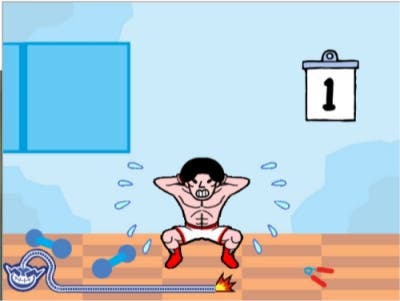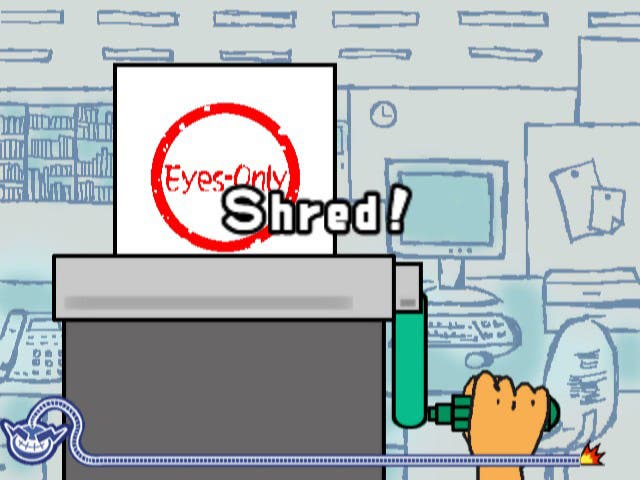Wario Ware: Smooth Moves
Touched by the hand of Twisted.
Is there no end to WarioWare's effortless appeal? As well as being one of our favourite handheld series of all-time, WarioWare games have also displayed an uncanny knack of perfectly demonstrating fairly abstract control systems in the most intuitive fashion possible.
Small wonder, then, that Smooth Moves arrives so soon after the launch to capitalise - as well as build - on the novelty value of the supremely capable motion sensitive Wii Remote.
Just like the previous four WarioWare titles released over the past four years, you're presented with a series of five-second 'microgames', where you have to respond instantly to the instructions by utilising the controls in an appropriate fashion. With a limited stock of lives at your disposal, you can afford to cock up three times along your way to the inevitable 'boss' encounter, but fail a fourth time and it's back to the start. Succeed, and another madcap series of mini-games unlocks - as usual, based around the adventures of old favourites like the funky Jimmy T, Spitz and 9-Volt.
Alas, Barry White...
But what differentiates Smooth Moves from the existing WarioWare titles is that it grants players a degree of prior explanation to the various control 'poses' you must adopt with the 'form baton' (i.e. the Wii Remote) the first time you come across them. Delivered with a creepy degree of ultra calm cod seriousness, a silvery voiced American narrator describes how each pose works as if he were addressing a trauma victim - but then you're straight into the action and never hear the explanation again.
Kicking off with the basic Remote Control form, you quickly rattle through games that involve little more than pointing at a target and shooting, or moving a torch light at a man hiding in the dark. Within the first few minutes, you'll already be familiar with the Umbrella form, where you must hold the remote aloft ("with the quiet dignity of a circus clown in the rain") and, for example, swat an insect. The Handlebar form, meanwhile, tasks you with turning the remote on its side and clasping it with both hands like a steering wheel - perfect for tilt-based games and, naturally, driving. For the first few rounds, at least, all are incredibly easy to grasp, and there's the unavoidable sense that we're very much in tutorial territory.
As you progress through the various characters, new variations on the basic forms get thrown into the mix. So, although we get introduced to the Elephant (pointing forward from your nose) and the Mohawk (pointing forward, held aloft over head), the Sketch Artist (held forward as if you were writing on the screen), the Waiter (held in the palm of your hand like a tray) and Tug O' War (held as if you were hauling a rope), you're essentially holding the 'form baton' in the same horizontal, forward-pointing orientation as The Remote Control form - the difference is, of course, the context, and by slightly altering the way you hold the remote, the actions required of you feel much more natural.
Spot the difference

Similarly, the Thumb Wrestler, the Janitor and Mortar and Pestle forms are held up like the Umbrella. Others, though, require more subtle differences - for example, the Boxer and the Dumbbell form both require the remote to be held flat sideways with one hand, but the latter with the remote pointing to the right, and the former pointing to the left. And while the Handlebar form looks initially similar to the Chauffeur, the latter requires you to fully tilt the controller towards your body, rather than horizontally. Failure to note the minor differences in form could cost you dear when the pressure's on and you're flapping haplessly, so it's worth always treating every form differently even when they appear to be broadly similar.
Beyond those, there are even more precise requirements - like the Big Cheese and the Samurai forms - where the game recommends you hold the remote at hip level and, for example, slash across the screen or wiggle your hips to keep the hula hoop in motion. The Discard form tasks you with placing the remote upside down on a flat stationary surface and, for example, answer a phone - complete with hilarious use of the built-in speaker. The Finger Food form stands alone as being the only one where you have to hold the remote on its side while pointed towards the screen, making it easier to do precise motions like sharpening a pencil, tuning a guitar or unlocking a door. Just one form actually requires that you plug in the Nunchuk - the Diner form, where you're required to hold them like a knife and fork - allowing all manner of dual limbed actions like pedalling a bicycle and then steering it.
Yet again, Nintendo effortlessly introduces a whole host of new control systems while making it an incredibly fun process getting to know them. Nintendo seems to have this incredible knack of being able to show you the ropes within its games, ensuring that you're never forced to run through a boring tutorial to learn how to play it.
Comic genius

And once you've familiarised yourself with all 19 forms in rapid succession, the game becomes less about being introduced to new control systems, and, thankfully, more about the hilarity involved in engaging with all 200 microgames. Needless to say, part of the joy of playing any WarioWare game is the joy of discovering new stuff (and, more to the point seeing what warped humour they can throw at you next), but the highlights are plentiful. Whether you're guzzling a drink without spilling it over your face, or placing the false teeth into the mouth of an old lady, or - the old favourite - trying to pick someone's nose, it's a game you'll play with a smile on your face throughout.
Just like the GameCube version, though, there's not a huge amount of mileage to be had out of playing it in single-player mode. Although all the microgames are new (unlike the GameCube version which recycled those found in the GBA original), you'll romp through them in a couple of hours. Admittedly you can return to each character and go for a high score, but it's not a game that necessarily benefits that greatly from repeat play. You can dive back into the Temple of Form and replay each individual game (by form or by story, handily), but there's no high score mode per game as such - just the option to play three increasingly difficult levels of each game and tweak the time settings via a slider.
That's not all there is to the single-player mode, fortunately. Along the way to unlocking all the game's major characters you'll also unlock a few standalone mini-games, such as Tower Tennis, where you have to ascend a tower by continually bouncing a ball, while avoiding - or breaking through - various blocks that bar your progress. Meanwhile, the NES-styled Can Shooter is an enjoyable, albeit straightforward old-school light-gun-style game, where you must shoot the cans as they drift across the screen before the time runs out. Some targets give you additional time, but as you progress it becomes increasingly tricky to snag them before they dart off-screen. Block Star, however, has a much more sedate pace, tasking you with stacking up an increasing number of falling blocks. To begin with it's a fairly perfunctory exercise, but a few levels down the line they begin falling at jaunty angles, making it an increasingly tricky business to balance your precarious load. As with everything WarioWare, they're lightweight and throwaway, but loveable all the same.









